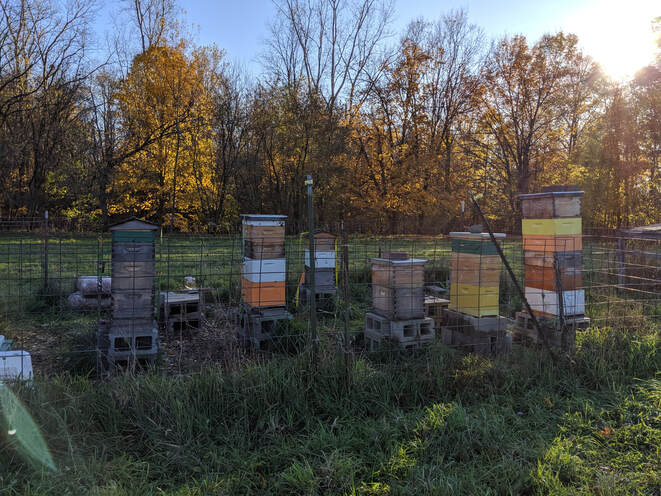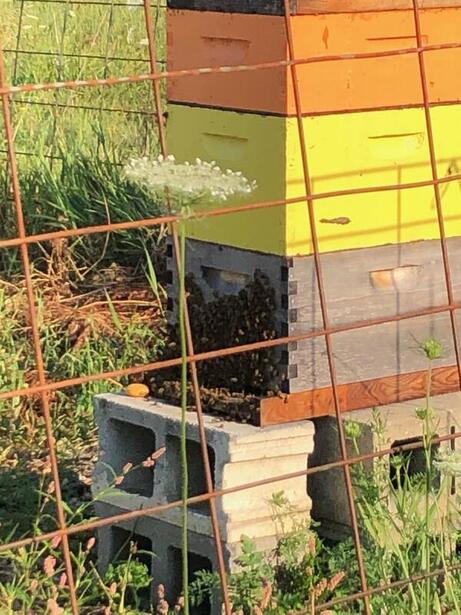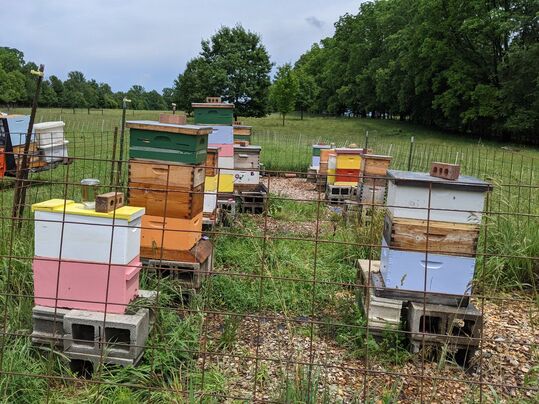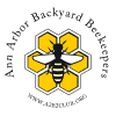 Aster In Michigan, basically the last call for nectar in the environment is mid-to-late September. This is when goldenrods and asters stop blooming. While some beekeepers choose to harvest this late-season honey and then feed their bees thicker 2:1 sugar syrup to build back up their winter stores, many just leave this odoriferous honey on the hives for their bees to enjoy during the winter. It’s important that every frame left behind in the hive for the winter has beautiful comb jammed full of honey that is easily accessible to the bees and that there are no gaps between the frames (i.e. not drawn out foundation frames) that would prevent bees from reaching their honey stores. This may require beekeepers to condense, rearrange, and even combine their hives in the fall. Remember, a hive needs between 60-100lbs of honey to survive the winter! Bombs Varroa, varroa, varroa. It doesn’t matter how sick you are of hearing about Varroa, they are still a major concern for beekeepers, especially in the fall. To reiterate how Varroa reproduces, it does so exponentially, with the peak mite population right at the decline of the honey bee population in the fall. So, even if you’ve tested all spring and summer and found low mite numbers (0-3 mites/100 bees or 0-9 mites/300 bees), YOU MAY STILL SEE A FALL EXPLOSION OF MITES in your colonies. Also of concern are mite bombs which are hives that haven’t been managed for mites all year and now collapse, sending infected bees out to overrun surrounding hives. So, you’re saying, no problem, I’ll just plan on treating all my hives in the middle of September, not testing, and calling in good, right? Wrong! Every area is a little different and if you treat a little too early or a little too late to control your mites, you can still suffer winter losses due to mites. Also, you should always test before and after a mite treatment to make sure your mite treatment was effective. Combining In addition to making sure your hives are disease-free, well-fed, and Varroa-controlled, fall is also the time to equalize your hives. What I mean by equalize is not going into winter with strong hives and weak hives, but combining and distributing frames such that all of your hives are robust going into winter. One bit of advice some beekeepers use is not to combine weak hives with weak hives, but to combine weak hives with strong hives for better success, while others like to combine 2 weak hives in the hope of making one stronger hive. When combining 2 hives, a single sheet of newspaper should be used between the boxes of the 2 hives so that the bees are gradually introduced to each other. Often the queen of the weak colony is dispatched before the combination, but this may not be necessary as often the bees sort out which queen they want to keep. Also, combining hives is a good way this late in the season to get a queen into a queenless or laying worker hive. Additional Information: https://www.honeybeesuite.com/fall-management-of-honey-bees/ https://www.youtube.com/watch?v=k1RcADkd_RA
1 Comment
 August Springtime signifies the honey flow, growth, reproduction for a honey bee colony. The hot months of summer are when honey bees begin winter preparations. The queen may slow down in her egg laying and the focus of the hive tips away from brood rearing to foraging for nectar and storing honey for the winter. However, brood rearing isn’t completely abandoned because this is also the time when the hive is making winter bees, bees with larger fat stores whose physiology allows them to live months instead of weeks. Drone production also slows as swarm season ends and the need for drones diminishes. Summer is also a tricky time for queens. If a hive has a late swarm or loses a queen, it may be too late in the season for them to make a new queen on their own and the beekeeper may have to introduce a queen into the queenless hive instead. You may also see a phenomenon called bearding on your hives in the summer. This is when bees come out of the hive and cover the outside of the hive, some staying near the entrance to fan and cool the hive. This behavior helps to keep the inside of the hive cool. Burglary Another concern of beekeepers in the summertime is the dearth. A dearth is when there is a lack of natural floral resources to provide the bees with nutrition (i.e. pollen and nectar). It is important to know what is blooming in the 6 miles around your apiary and when. Local weather can very so much that beekeepers even within a few miles of each other may have very different floral resources for their bees. Many beekeepers will feed their hives 2:1 sugar syrup in the late summer to bolster their winter honey stores, especially if there are drought conditions. With the dearth also comes robbing. Robbing is when either other honey bees or nectar-seeking insects like wasps will invade a weak hive and steal the stored honey from that hive, further weakening and often killing the colony being robbed in the process. Robbing screens can help with this problem as well as using feeders that are completely enclosed inside the hive. Caution Just as the population of a honey bee hive starts to wane in the summer, the Varroa mite populations in a hive begin to peak. If no steps are taken to test for and treat mites when the mite population spikes, then a beekeeper may find themselves with a dying colony in the fall. It is important to note that not all mite treatments can be used when honey supers are on the hive or when temperatures are above 85 degrees Fahrenheit, so it’s important to read the labels of products you are thinking about using. The label is the law! More information: https://www.honeybeesuite.com/summer-nectar-dearth-honey-bee-management/ https://cals.cornell.edu/pollinator-network/beekeeping/beekeeping-calendar-northeast |
AuthorJen Haeger is a new master beekeeper and board member of A2B2. Archives
August 2022
Categories
All
|


 RSS Feed
RSS Feed
